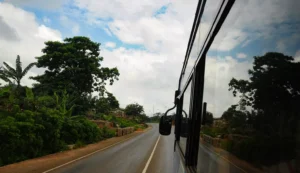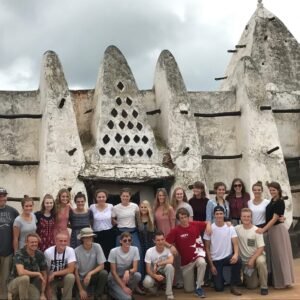While Ghana’s major tourist destinations like Cape Coast, Mole National Park, and Accra attract much of the spotlight, the country is full of lesser-known treasures waiting to be explored. These hidden gems offer authentic experiences, fewer crowds, and deep connections to Ghana’s diverse landscapes, cultures, and communities.
If you’re the kind of traveler who enjoys stepping off the beaten path, here are eight under-the-radar destinations in Ghana that are absolutely worth the journey.
1. Nzulezo – The Village on Stilts
Location: Western Region, near Beyin
Why Go: Experience life on water in a centuries-old stilt village built entirely over Lake Tadane.
Nzulezo is a unique destination accessible only by canoe through a maze of wetlands. The village is home to the Nzema people, and despite its isolation, it thrives with daily life suspended above the lake.
What to Expect:
- Peaceful canoe ride through tropical wetlands
- Insight into traditional stilt-house architecture
- Community-led guided tours
Travel Tip: Combine with a visit to Fort Apollonia and nearby Beyin Beach.
2. Tagbo Falls and Mount Gemi – Volta Region
Location: Near Liati Wote, Volta Region
Why Go: Hike through lush rainforest to discover Ghana’s second-highest waterfall and a panoramic mountain viewpoint.
While Wli Falls gets most of the attention, Tagbo Falls is a quieter, more intimate experience. The surrounding forest paths and trails to Mount Gemi make it ideal for nature lovers and hikers.
What to Do:
- Short trek to the multi-level Tagbo Falls
- Climb Mount Gemi for views stretching into Togo
- Explore the Ewe village of Liati Wote
Best Time: During or just after the rainy season (May–October) when the falls are strongest.
3. Bui National Park – Untouched Wilderness and Hippos
Location: Bono Region, near Banda-Ahenkro
Why Go: Discover Ghana’s second-largest national park with river safaris, hippos, and birdwatching in remote tranquility.
Located along the Black Volta River, Bui National Park is an unspoiled haven for nature enthusiasts.
Highlights:
- Spot hippos in their natural habitat
- Go canoeing on the Black Volta
- Hike through savannah and forest terrain
Tip: Accommodation is basic—this is a destination for true adventure seekers.
4. Amansuri Wetlands – Birdwatcher’s Paradise
Location: Near Beyin, Western Region
Why Go: One of Ghana’s most important biodiversity hotspots, perfect for birding and eco-tourism.
The Amansuri Wetlands are part of a protected area of swamps, lagoons, and mangrove forests. It’s rich in birdlife and best explored by canoe.
What to Expect:
- Guided canoe tours with local eco-guides
- Viewings of herons, kingfishers, and rare bird species
- Serene early-morning or sunset paddles
Nearby Attractions: Nzulezo and Fort Apollonia
5. Kintampo Waterfalls – Midway Oasis
Location: Bono East Region, along the Techiman–Kintampo road
Why Go: A cascading waterfall tucked into a lush forest grove, right in the center of the country.
Kintampo Falls is a fantastic stopover on the way to northern Ghana and remains under-visited despite its beauty and accessibility.
Features:
- Tiered falls cascading over rocky ledges
- Natural pool for swimming
- Family-friendly setting with picnic areas
Tip: Go early to beat weekend crowds and enjoy the peaceful setting.
6. Larbanga Mosque – Oldest Mosque in Ghana
Location: Savannah Region, near Mole National Park
Why Go: A spiritual and architectural relic built in the Sudanese-Sahelian style over 600 years ago.
Larbanga Mosque is a small yet powerful piece of Ghanaian Islamic heritage. Its mud and wood construction has been preserved with community effort and UNESCO support.
Highlights:
- Traditional architecture and local folklore
- Guided tour by village elders
- Combine with a visit to Mole National Park
Cultural Note: Non-Muslims may not enter but can tour the exterior and surrounding compound.
7. Tongo Hills and Tengzug Shrine – Sacred Rock Formations
Location: Upper East Region, near Bolgatanga
Why Go: A spiritual and geological marvel offering insight into ancient Talensi customs and dramatic rocky landscapes.
Tongo Hills are home to the Tengzug Shrine, where rituals and sacrifices are still practiced today. The hike through the hills is equally rewarding for its views and unique rock formations.
What to Expect:
- Spiritual ceremonies and guided storytelling
- Climbing narrow rock passages to the shrine
- Panoramic views of the savannah
Visitor Etiquette: Visitors must remove shirts and shoes at certain sacred areas—respectful attire and behavior is important.
8. Boabeng-Fiema Monkey Sanctuary – Sacred Wildlife Conservation
Location: Bono East Region, near Nkoranza
Why Go: A rare opportunity to walk freely among monkeys in a forest where they’re protected by local taboos.
Boabeng-Fiema is a village sanctuary where black-and-white colobus and mona monkeys coexist peacefully with humans, thanks to traditional beliefs that revere the animals as sacred.
What You’ll Experience:
- Monkeys wandering through village streets
- Guided forest walks
- Learn about traditional animal protection laws
Best Time to Visit: Morning or late afternoon when monkey activity peaks.
Map Your Route: Hidden Gems Overview
| Destination | Region | Main Attraction | Best For |
|---|---|---|---|
| Nzulezo | Western | Village on stilts over water | Cultural immersion |
| Tagbo Falls & Mt. Gemi | Volta | Waterfalls and hiking | Nature lovers and hikers |
| Bui National Park | Bono | River safaris, hippos | Adventure and wildlife |
| Amansuri Wetlands | Western | Birdwatching and eco-tours | Birders, canoeing |
| Kintampo Waterfalls | Bono East | Multi-level waterfall | Family-friendly nature escape |
| Larabanga Mosque | Savannah | Ancient Islamic architecture | Heritage tourism |
| Tongo Hills & Shrine | Upper East | Rock formations and spiritual sites | Sacred history and hiking |
| Boabeng-Fiema Sanctuary | Bono East | Monkeys living with humans | Conservation and culture |
Travel Tips for Exploring Ghana’s Hidden Gems
- Use a local guide: Many of these sites are managed by small communities. Hiring a guide supports the locals and enriches your experience.
- Pack wisely: Bring sturdy footwear, insect repellent, and plenty of water for hikes and remote travel.
- Respect local customs: Especially at shrines or sacred forests—always ask before taking photos.
- Prepare for basic facilities: In remote areas, lodging and amenities may be simple or rustic.
- Combine with major destinations: Plan your route to visit these gems as part of a broader itinerary to Cape Coast, Mole, or Kumasi.
Conclusion
Beyond Ghana’s most famous attractions lies a world of hidden beauty and cultural depth. Whether it’s a floating village, a secret waterfall, or a monkey sanctuary protected by tradition, these off-the-beaten-path places offer meaningful encounters and unforgettable stories. For first-timers and seasoned travelers alike, Ghana’s hidden gems are proof that the road less traveled often leads to the richest experiences.




